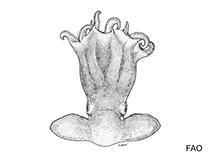Cirroctopus hochbergi O'Shea, 1999
Envoyez vos Photos
Images Google | No image available for this species;
drawing shows typical species in Cirroctopodidae.
Images Google | No image available for this species;
drawing shows typical species in Cirroctopodidae.
Classification / Names Common names | Synonyms | CoL | ITIS | WoRMS
Cephalopoda | Octopoda | Cirroctopodidae
Environment: milieu / climate zone / depth range / distribution range Écologie
. Subtropical
Distribution Pays | Zones FAO | Écosystèmes | Occurrences | Introductions
Southwest Pacific.
Length at first maturity / Taille / Poids / Âge
Maturity: Lm ? range ? - ? cm
Life cycle and mating behavior Maturité | Reproduction | Frai | Œufs | Fécondité | Larves
Members of the class Cephalopoda are gonochoric. Male and female adults usually die shortly after spawning and brooding, respectively. Mating behavior: Males perform various displays to attract potential females for copulation. During copulation, male grasp the female and inserts the hectocotylus into the female's mantle cavity where fertilization usually occurs. Life cycle: Embryos hatch into planktonic stage and live for some time before they grow larger and take up a benthic existence as adults.
Référence principale
Références | Coordinateur | Collaborateurs
Wood, J.B. and C.L. Day. 1998. (Ref. 3722)
Statut dans la liste rouge de l'IUCN (Ref. 130435: Version 2024-1)
Menacé (EN) (A2bc; C1); Date assessed: 20 August 2014
statut CITES (Ref. 108899)
Not Evaluated
CMS (Ref. 116361)
Not Evaluated
Menace pour l'homme
Utilisations par l'homme
| FishSource |
Outils
Plus d'informations
Trophic Ecology
Éléments du régime alimentaire
Régime alimentaire
Consommation alimentaire
Ration
Prédateurs
Régime alimentaire
Consommation alimentaire
Ration
Prédateurs
Ecology
Écologie
Home ranges
Home ranges
Population dynamics
Croissance
Taille/Âge
Longueur-poids
Longueur-longueur
Fréquences de longueurs
Mass conversion
Recrutement
Abondance
Taille/Âge
Longueur-poids
Longueur-longueur
Fréquences de longueurs
Mass conversion
Recrutement
Abondance
Life cycle
Reproduction
Maturité
Fécondité
Frai
Œufs
Développement de l'œuf
Larves
Dynamique des populations larvaires
Maturité
Fécondité
Frai
Œufs
Développement de l'œuf
Larves
Dynamique des populations larvaires
Distribution
Human Related
Profil d'aquaculture
Stamps, Coins Misc.
Stamps, Coins Misc.
Outreach
References
Sources Internet
BHL | BOLD Systems | CISTI | DiscoverLife | FAO(Publication : search) | Fishipedia | GenBank (genome, nucleotide) | GloBI | Gomexsi | Google Books | Google Scholar | Google | PubMed | Arbre de Vie | Wikipedia (Go, chercher) | Zoological Record



